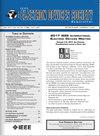Self-Assembled Multilayer Single-Walled Carbon Nanotube Thin Film Transistors and Doping Regulation
IF 2
3区 工程技术
Q3 ENGINEERING, ELECTRICAL & ELECTRONIC
引用次数: 0
Abstract
Semiconducting single-walled carbon nanotubes (SWCNTs) have stimulated tremendous research interest in high performance electronics thanks to their impressive mechanical and electronic properties. However, it is still challenging to prepare wafer-scale SWCNTs thin films and fine-tunable device performance. Here, layer-by-layer (LbL) assembly is presented as an effective approach to prepare multilayer SWCNT thin films by coordinating poly(diallyldimethylammonium chloride) (PDDA) with SWCNTs. The thickness of SWCNTs thin film is linearly dependent on the bilayer numbers. Thin film transistors (TFTs) fabricated from SWCNTs thin films showed prominent device performance with a mobility of自组装多层单壁碳纳米管薄膜晶体管及掺杂调控
半导体单壁碳纳米管(SWCNTs)由于其优异的机械和电子性能,在高性能电子学领域引起了巨大的研究兴趣。然而,制备晶圆级SWCNTs薄膜和可调器件性能仍然具有挑战性。在这里,层接层(LbL)组装被认为是一种通过配位聚二烯基二甲基氯化铵(PDDA)和SWCNTs来制备多层SWCNTs薄膜的有效方法。SWCNTs薄膜的厚度与双分子层数呈线性关系。由SWCNTs薄膜制备的薄膜晶体管(TFTs)具有优异的器件性能,迁移率为$\rm 15.3 cm_{2} \cdot V_{1}\cdot s_{1}$。此外,利用具有强吸电能力和质子化性质的分子掺杂剂双(三氟甲烷)磺酰亚胺(TFSI)对SWCNTs薄膜进行功能化,从而调节其电子性能。TFSI表面功能化可以去除swcnts薄膜上多余的电子,从而改善导通电流,增加载流子迁移率和正位移阈值电压。分子掺杂在未来实现大面积、低功耗逻辑电路和高性能电子器件方面具有很大的前景。
本文章由计算机程序翻译,如有差异,请以英文原文为准。
求助全文
约1分钟内获得全文
求助全文
来源期刊

IEEE Journal of the Electron Devices Society
Biochemistry, Genetics and Molecular Biology-Biotechnology
CiteScore
5.20
自引率
4.30%
发文量
124
审稿时长
9 weeks
期刊介绍:
The IEEE Journal of the Electron Devices Society (J-EDS) is an open-access, fully electronic scientific journal publishing papers ranging from fundamental to applied research that are scientifically rigorous and relevant to electron devices. The J-EDS publishes original and significant contributions relating to the theory, modelling, design, performance, and reliability of electron and ion integrated circuit devices and interconnects, involving insulators, metals, organic materials, micro-plasmas, semiconductors, quantum-effect structures, vacuum devices, and emerging materials with applications in bioelectronics, biomedical electronics, computation, communications, displays, microelectromechanics, imaging, micro-actuators, nanodevices, optoelectronics, photovoltaics, power IC''s, and micro-sensors. Tutorial and review papers on these subjects are, also, published. And, occasionally special issues with a collection of papers on particular areas in more depth and breadth are, also, published. J-EDS publishes all papers that are judged to be technically valid and original.
 求助内容:
求助内容: 应助结果提醒方式:
应助结果提醒方式:


